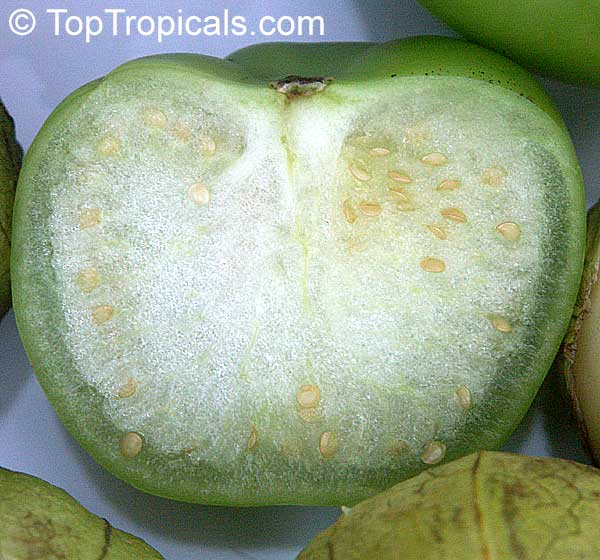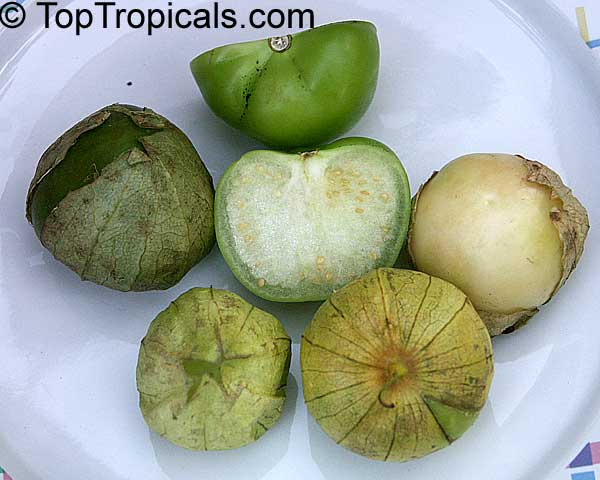Physalis philadelphica (Tomatillo)
Top Tropicals Plant Encyclopedia
Botanical name: Physalis philadelphica
Common names: Tomatillo, Husk Tomato
Family: Solanaceae
Origin: Mexico





The tomatillo is believed to have originated in Mexico, and is widely cultivated around the world. The fruit is a green berry enclosed in a bladder-like husk and grows in clusters. It matures to yellow or orange, and when husked, is ready to be cooked. Tomatillos provide several health benefits. They are rich in vitamin C, potassium, calcium, iron, and phosphorus so they can help protect the immune system, reduce inflammation, and support the body's metabolism. In addition, the vitamin C content of tomatillos is about twice that of a green pepper, making them helpful for boosting the body's antioxidant response. As a small shrub, Physalis philadelphica grows from 2 to 5 feet tall, and cultivars are available with double or triple flowers. The plant is grown in USDA Hardiness Zones 9-11. It requires full sun and regular water. The tomatillo prefers soil with good drainage and should be pruned regularly to keep the plant tidy and encourage fruiting. This plant can live through mild winters in colder climates, but will need to be grown in a container and brought inside during harsher winters. Tomatillos produce an abundance of fruit, with each plant potentially producing up to two quarts of fruit per season. When cooked or boiled, the fruits are perfect for preparing green sauces, salsas, and jams. The tart flavor they offer is enjoyed in both sweet and savory recipes. They can also be eaten raw or added to salads as a crunchy treat.
Physalis philadelphica, commonly known as Tomatillo, is a small shrub native to Mexico and is now grown in gardens worldwide. This ethnomedical plant is famous for its tart flavor and is used in a range of Mexican green sauces and dishes. Growing to a height of 2-5ft, the tomatillo produces an edible fruit that is enclosed in a thick, brown husk and turns yellowish when ripe. This plant prefers fertile soil, ample water, and full sun, and it is best planted after frost has passed. Tomatillos should be planted 18-inches apart in rows three feet apart, and the mature fruit will be ready to harvest in about 120 days. The fruit can be kept in the refrigerator for two weeks, or frozen whole or sliced.
Tomatillos are highly nutritious and are a great source of vitamin C, potassium, calcium, iron, and phosphorus. In Mexico, a concoction made of Calyxes from the flowers is used to treat diabetes and the fruit itself is used as a remedy to reduce fever. Tomatillos are a good source of antioxidants, and are often cooked or boiled for use in green sauces, salsas, and jams. The tart taste is also enjoyed when eaten raw or as added to salads.
In cold climates, Physalis philadelphica will need to be grown in containers and brought indoors when the temperature drops low. Despite requiring a bit of extra care, the tomatillo is a highly fruitful plant, with each plant producing up to two quarts of fruit in a season. With the right care and attention, this delicious and healthy plant can provide plenty of benefits for the home gardener.

